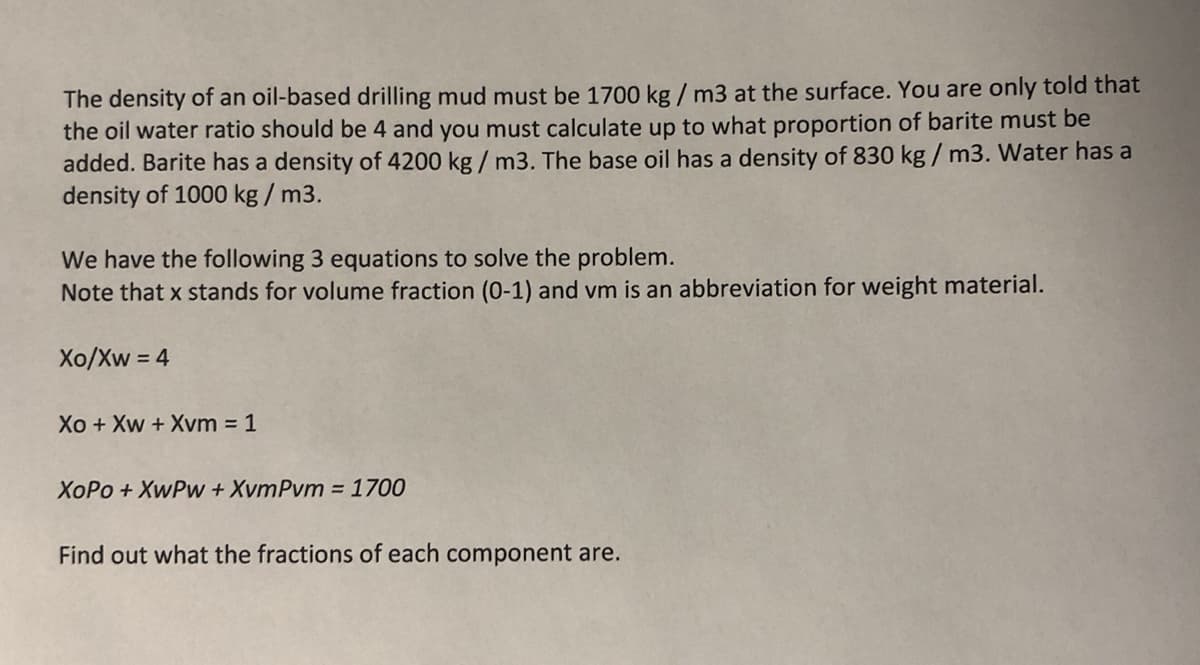The density of an oil-based drilling mud must be 1700 kg / m3 at the surface. You are only told that the oil water ratio should be 4 and you must calculate up to what proportion of barite must be added. Barite has a density of 4200 kg / m3. The base oil has a density of 830 kg / m3. Water has a density of 1000 kg / m3. We have the following 3 equations to solve the problem. Note that x stands for volume fraction (0-1) and vm is an abbreviation for weight material. Xo/Xw = 4 Xo + Xw + Xvm = 1 XoPo + XwPw+ XvmPvm = 1700 Find out what the fractions of each component are.
The density of an oil-based drilling mud must be 1700 kg / m3 at the surface. You are only told that the oil water ratio should be 4 and you must calculate up to what proportion of barite must be added. Barite has a density of 4200 kg / m3. The base oil has a density of 830 kg / m3. Water has a density of 1000 kg / m3. We have the following 3 equations to solve the problem. Note that x stands for volume fraction (0-1) and vm is an abbreviation for weight material. Xo/Xw = 4 Xo + Xw + Xvm = 1 XoPo + XwPw+ XvmPvm = 1700 Find out what the fractions of each component are.
Introduction to Chemical Engineering Thermodynamics
8th Edition
ISBN:9781259696527
Author:J.M. Smith Termodinamica en ingenieria quimica, Hendrick C Van Ness, Michael Abbott, Mark Swihart
Publisher:J.M. Smith Termodinamica en ingenieria quimica, Hendrick C Van Ness, Michael Abbott, Mark Swihart
Chapter1: Introduction
Section: Chapter Questions
Problem 1.1P
Related questions
Question

Transcribed Image Text:The density of an oil-based drilling mud must be 1700 kg/ m3 at the surface. You are only told that
the oil water ratio should be 4 and you must calculate up to what proportion of barite must be
added. Barite has a density of 4200 kg / m3. The base oil has a density of 830 kg/ m3. Water has a
density of 1000 kg / m3.
We have the following 3 equations to solve the problem.
Note that x stands for volume fraction (0-1) and vm is an abbreviation for weight material.
Xo/Xw = 4
Xo + Xw + Xvm = 1
XoPo + XwPw + XvmPvm = 1700
Find out what the fractions of each component are.
Expert Solution
This question has been solved!
Explore an expertly crafted, step-by-step solution for a thorough understanding of key concepts.
This is a popular solution!
Trending now
This is a popular solution!
Step by step
Solved in 2 steps

Knowledge Booster
Learn more about
Need a deep-dive on the concept behind this application? Look no further. Learn more about this topic, chemical-engineering and related others by exploring similar questions and additional content below.Recommended textbooks for you

Introduction to Chemical Engineering Thermodynami…
Chemical Engineering
ISBN:
9781259696527
Author:
J.M. Smith Termodinamica en ingenieria quimica, Hendrick C Van Ness, Michael Abbott, Mark Swihart
Publisher:
McGraw-Hill Education

Elementary Principles of Chemical Processes, Bind…
Chemical Engineering
ISBN:
9781118431221
Author:
Richard M. Felder, Ronald W. Rousseau, Lisa G. Bullard
Publisher:
WILEY

Elements of Chemical Reaction Engineering (5th Ed…
Chemical Engineering
ISBN:
9780133887518
Author:
H. Scott Fogler
Publisher:
Prentice Hall

Introduction to Chemical Engineering Thermodynami…
Chemical Engineering
ISBN:
9781259696527
Author:
J.M. Smith Termodinamica en ingenieria quimica, Hendrick C Van Ness, Michael Abbott, Mark Swihart
Publisher:
McGraw-Hill Education

Elementary Principles of Chemical Processes, Bind…
Chemical Engineering
ISBN:
9781118431221
Author:
Richard M. Felder, Ronald W. Rousseau, Lisa G. Bullard
Publisher:
WILEY

Elements of Chemical Reaction Engineering (5th Ed…
Chemical Engineering
ISBN:
9780133887518
Author:
H. Scott Fogler
Publisher:
Prentice Hall


Industrial Plastics: Theory and Applications
Chemical Engineering
ISBN:
9781285061238
Author:
Lokensgard, Erik
Publisher:
Delmar Cengage Learning

Unit Operations of Chemical Engineering
Chemical Engineering
ISBN:
9780072848236
Author:
Warren McCabe, Julian C. Smith, Peter Harriott
Publisher:
McGraw-Hill Companies, The